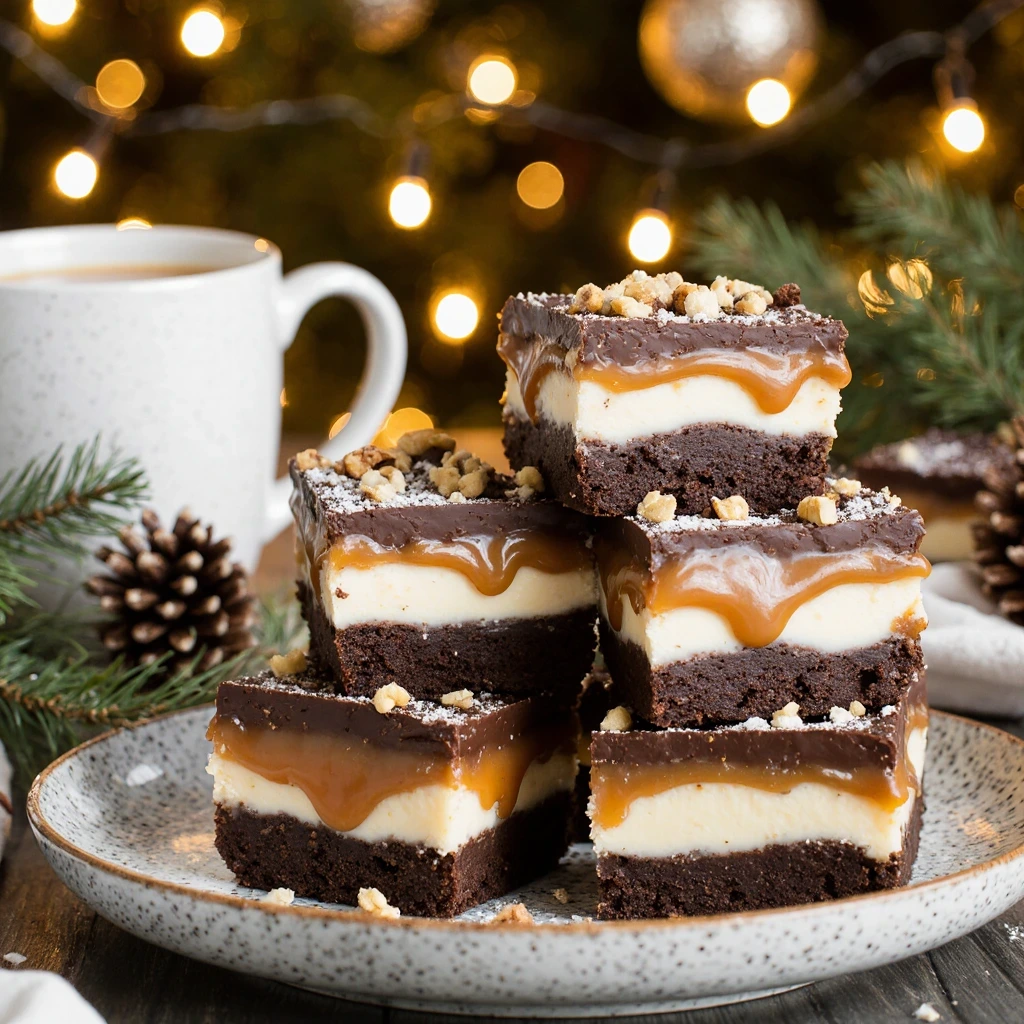Classic Christmas Toffee Recipe | Festive Holiday Dessert
When the holiday season arrives, few desserts capture the magic of Christmas as perfectly as Classic Toffee. This buttery, crunchy, golden treat is a timeless favorite that brings families together and delights guests at every gathering. In this post, we will dive deep into the story, preparation, variations, storage tips, and serving ideas of this beloved Christmas dessert. Whether you are a seasoned baker or someone preparing festive recipes for the first time, this comprehensive guide will walk you through every detail you need to make your own perfect Classic Christmas Toffee.
The Charm of Classic Toffee at Christmas
There is something nostalgic about Classic Toffee. The combination of golden caramelized sugar and butter, topped with rich chocolate and sprinkled with nuts, creates a dessert that feels luxurious yet homey. During Christmas, the scent of toffee simmering on the stove fills the house with warmth and joy. It’s not just a dessert; it’s a tradition. Many families pass down toffee recipes from one generation to the next, making it an essential part of their holiday celebrations. Unlike other desserts that can be overly elaborate, Classic Toffee captures the spirit of Christmas with its simplicity and elegance.
Why Classic Toffee is a Must for Holiday Recipes
There are countless Christmas recipes out there, but Classic Toffee stands out for its balance of flavor, ease of preparation, and versatility. It can be enjoyed on its own, packaged as edible gifts, or incorporated into other desserts like ice cream toppings or cookie crumbles. The crunchy texture contrasts beautifully with creamy chocolate, making every bite indulgent yet satisfying. Because the recipe uses only a handful of ingredients—sugar, butter, chocolate, and nuts—it is both budget-friendly and easy to customize. This makes Classic Toffee one of the best Christmas desserts for large family gatherings.
A Brief History of Toffee
Classic Toffee has roots in European confectionery traditions. The word “toffee” first appeared in the English language during the early 19th century, likely derived from the Creole word “toughy” or “tafia,” which referred to a sugar-based treat flavored with rum. Traditionally, toffee was made by boiling sugar and butter together until it reached a hard crack stage. Over the years, variations emerged around the world, with each culture adding its own twist—some added molasses, while others introduced cream or spices. In England, toffee became a staple in sweet shops, while in the United States, toffee evolved into the chocolate-topped, nut-sprinkled dessert we now associate with Christmas.
Ingredients for Classic Christmas Toffee
One of the joys of making Classic Toffee is how few ingredients you need. Here’s the base recipe for a traditional batch:
-
1 cup unsalted butter
-
1 cup granulated sugar
-
1/4 teaspoon salt
-
1 teaspoon vanilla extract
-
1 cup semi-sweet chocolate chips (or high-quality chocolate bars chopped)
-
1/2 cup chopped nuts (almonds, pecans, or walnuts are common)
These ingredients are pantry staples, yet when combined, they create a rich and festive dessert. The butter and sugar form the base toffee layer, the chocolate creates a smooth topping, and the nuts provide crunch and flavor.
Step-by-Step Recipe for Classic Toffee
Making Classic Christmas Toffee requires attention to detail, but the steps are straightforward. Here’s how you can prepare it:
-
Prepare the pan: Line a baking sheet with parchment paper or a silicone baking mat. This ensures the toffee doesn’t stick.
-
Melt butter and sugar: In a heavy-bottomed saucepan, combine butter, sugar, and salt over medium heat. Stir constantly with a wooden spoon or heatproof spatula.
-
Cook to hard crack stage: Continue cooking until the mixture reaches 300°F (hard crack stage) on a candy thermometer. The mixture should turn golden brown. This step is crucial for achieving the right crunch.
-
Add vanilla: Remove from heat and stir in vanilla extract.
-
Spread the toffee: Pour the hot mixture onto the prepared baking sheet and spread evenly.
-
Add chocolate: Immediately sprinkle chocolate chips over the hot toffee. Let them sit for a minute to melt, then spread with a spatula into an even layer.
-
Top with nuts: Sprinkle chopped nuts over the chocolate layer. Gently press them in so they stick.
-
Cool and break: Allow the toffee to cool completely at room temperature or refrigerate until firm. Once hardened, break it into irregular pieces.
Pro Tips for Perfect Classic Toffee
-
Use a candy thermometer to avoid undercooking or burning the sugar mixture.
-
Stir consistently but gently—too much stirring can cause the sugar to crystallize.
-
Toast your nuts beforehand to enhance their flavor.
-
If you prefer a smoother surface, spread the toffee in a smaller pan for thicker pieces.
Flavor Variations for Classic Christmas Toffee
The beauty of Classic Toffee lies in its versatility. Here are some festive twists:
-
Spiced Toffee: Add cinnamon, nutmeg, or ginger to the toffee base for warm holiday flavors.
-
White Chocolate Toffee: Replace dark chocolate with white chocolate for a sweeter, creamier version.
-
Peppermint Toffee: Crush candy canes and sprinkle them over the chocolate layer for a refreshing holiday touch.
-
Salted Toffee: Finish with a sprinkle of flaky sea salt to balance sweetness with a savory edge.
-
Nut-Free Toffee: Skip the nuts and use crushed pretzels or cookie crumbs instead.
Serving Ideas for Christmas Desserts
Classic Toffee can shine in many festive settings. Serve it on a dessert platter alongside cookies and fudge, use it as a garnish for ice cream sundaes, or crumble it into trifle recipes. For Christmas parties, package pieces in decorative tins or cellophane bags tied with ribbons. This makes for an affordable yet thoughtful gift that embodies the season’s spirit. Pairing toffee with hot cocoa, mulled wine, or coffee elevates the indulgence even more.
Storage and Shelf Life of Classic Toffee
Homemade Classic Toffee keeps remarkably well if stored properly. Place it in an airtight container, layering parchment paper between pieces to prevent sticking. It can last up to two weeks at room temperature and even longer in the refrigerator. For extended storage, freeze toffee in sealed freezer bags for up to three months. Just be sure to thaw it at room temperature to avoid moisture ruining the texture.
Why Classic Toffee is a Timeless Dessert
In the world of Christmas recipes, some desserts fade in and out of popularity, but Classic Toffee endures. Its simplicity makes it approachable, while its rich flavors make it feel indulgent. It appeals to all ages, from children who love the crunch to adults who savor the caramel notes and chocolate topping. More importantly, making Classic Toffee is as much about the process as the result—it’s a ritual that brings families into the kitchen, creating memories that last long after the holiday season.
Frequently Asked Questions (FAQs)
1. Can I make Classic Toffee without a candy thermometer?
Yes, but it is riskier. Use the cold water test—drop a small amount into ice water. If it forms brittle strands that snap, it has reached the hard crack stage.
2. What kind of nuts work best for Classic Toffee?
Almonds are the most traditional, but pecans, hazelnuts, or walnuts also pair beautifully with chocolate and caramelized sugar.
3. Why did my toffee turn grainy?
This usually happens if sugar crystals form on the sides of the pan. To avoid this, brush down the sides with a wet pastry brush while cooking.
4. Can Classic Toffee be made ahead of time?
Absolutely. Toffee is a great make-ahead dessert because it stores well and even tastes better after sitting for a day.
5. Can I double the recipe for larger batches?
Yes, but use a larger pan and a heavy-bottomed pot to ensure even cooking. Be prepared to work quickly when spreading the mixture.
6. Is Classic Toffee gluten-free?
Yes, the basic recipe is naturally gluten-free, though you should check that your chocolate and any toppings are certified gluten-free.
7. What chocolate works best?
High-quality semi-sweet or dark chocolate balances the sweetness of the toffee. Avoid low-quality chocolate that may not melt smoothly.
8. How do I make vegan toffee?
Substitute butter with vegan margarine and use dairy-free chocolate. The texture and flavor remain delicious.
9. Can I give toffee as a Christmas gift?
Yes, packaged Classic Toffee makes a perfect edible gift. Use decorative jars, tins, or festive wrapping to make it extra special.
10. How thick should the toffee layer be?
Aim for 1/4 to 1/2 inch thick. Too thin and it may burn, too thick and it becomes hard to bite.
Conclusion
Classic Toffee is more than just a Christmas dessert; it’s a symbol of togetherness, tradition, and celebration. With its buttery crunch, rich chocolate topping, and customizable flavors, it has earned a permanent spot in the collection of cherished holiday recipes. Whether you are serving it at a family gathering, gifting it to friends, or simply enjoying a piece with your evening coffee, Classic Christmas Toffee is the perfect way to sweeten the season. By following the steps and tips outlined in this post, you can master the art of toffee-making and create a dessert that will be remembered and requested year after year.


